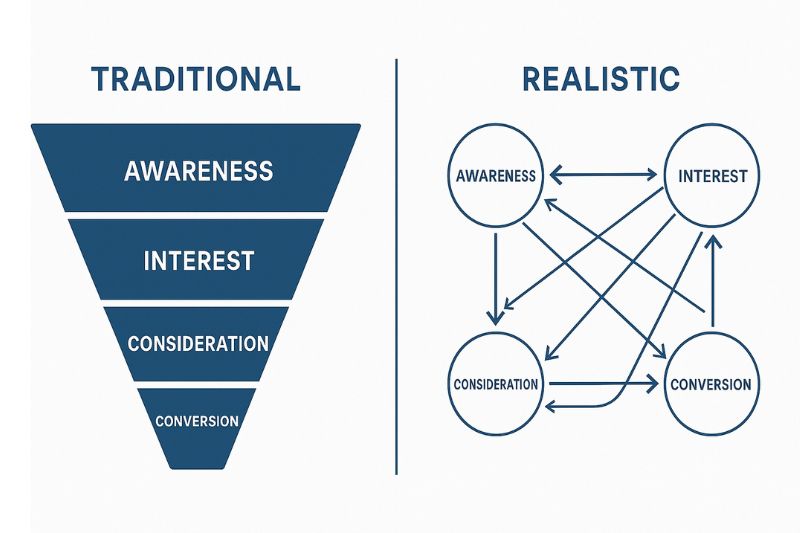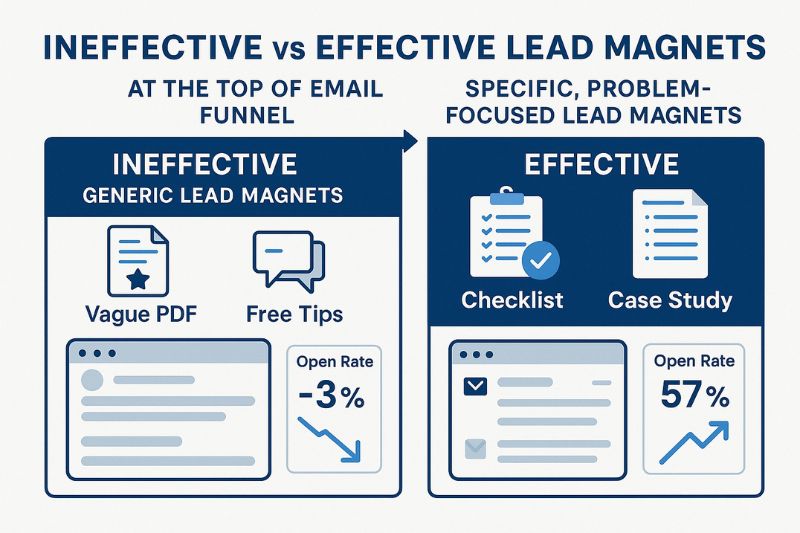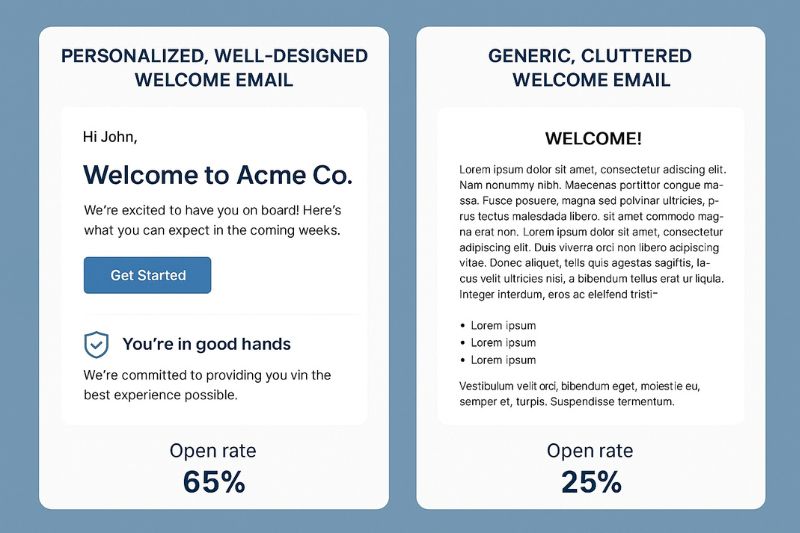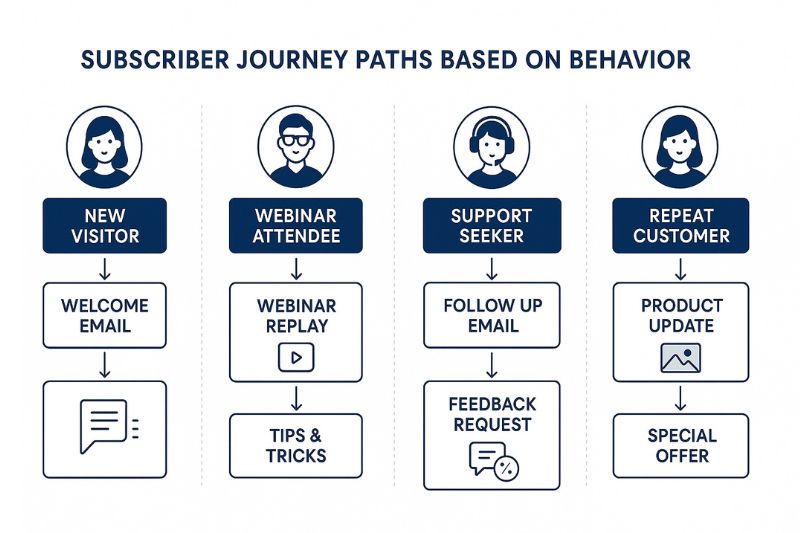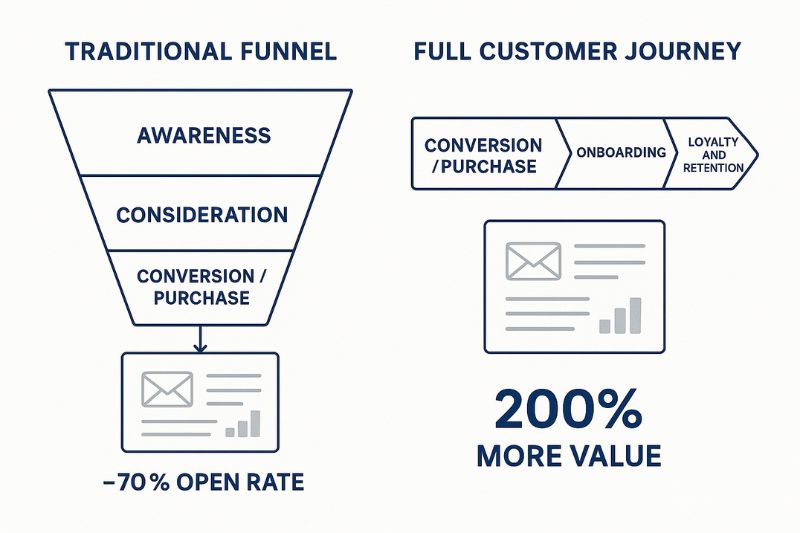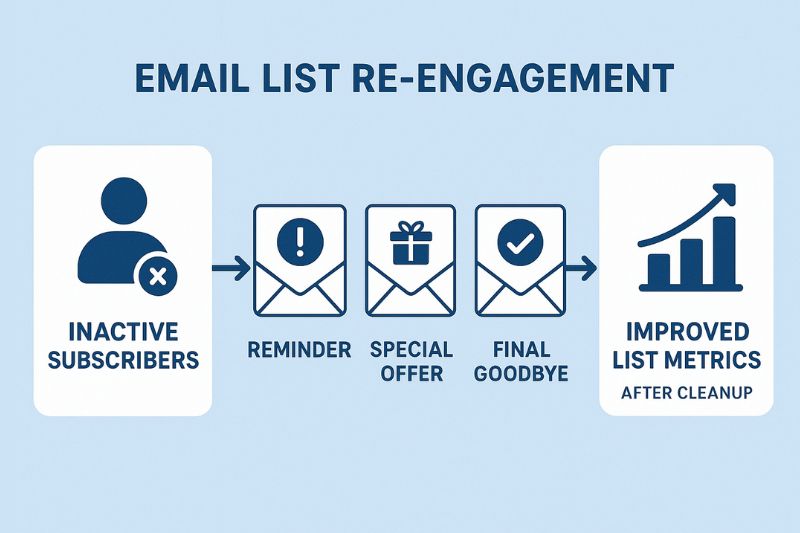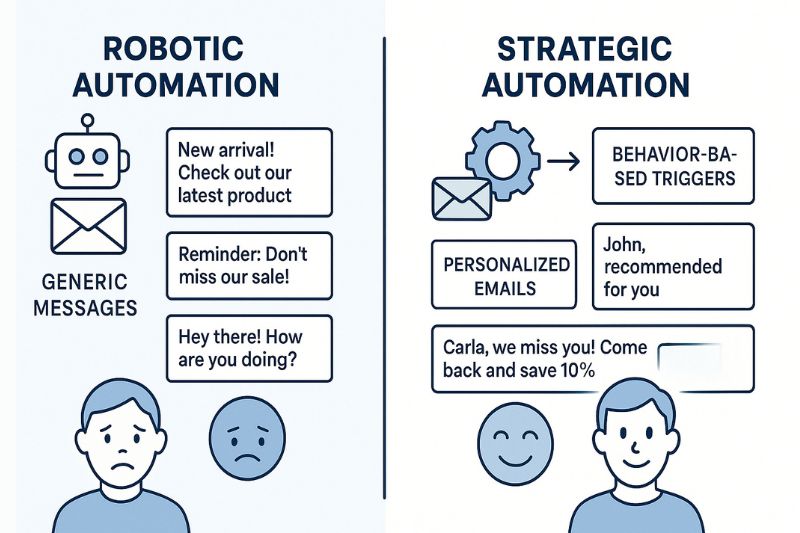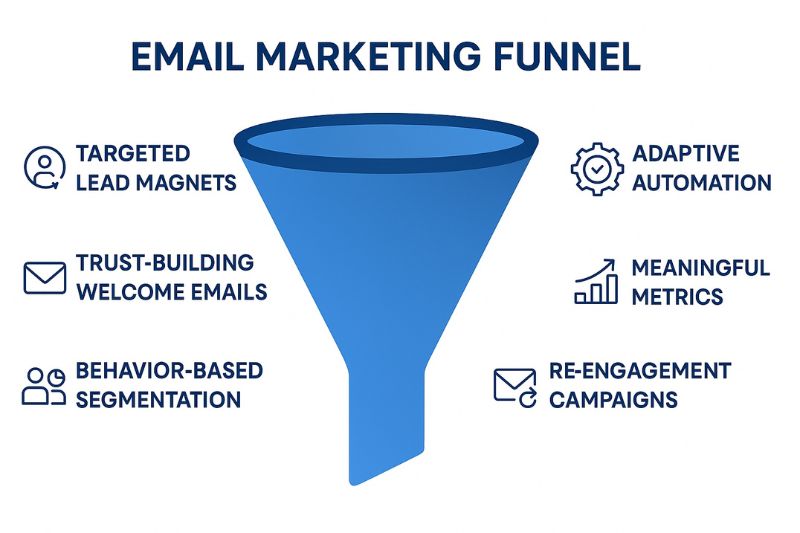If you’ve ever built an email funnel and felt like it didn’t quite work the way it should, you’re not alone.
It’s not because your copy was weak, or your subject lines, or even your offer. It’s because the way people move through email funnels is messy, inconsistent, and deeply personal. Yet, most email advice still assumes that everyone calmly progresses from one stage to the next.
In this post, we’ll rethink the marketing funnel itself—how it works, where you can expect issues, and what to do when your target audience doesn’t behave the way your diagram says they should.
You’ll learn:
- Why most marketing strategies backfire
- How to stop forcing subscribers into the same customer journey
- What metrics tell you when your funnel is broken
- And where deliverability makes or breaks your results
Let’s take a closer look at how email funnels work nowadays, and how to build one that delivers awesome results!
The funnel everyone draws (and why it rarely works)
You know the diagram: Awareness stage → Interest stage → Consideration stage • Conversion → Retention. Clean, predictable, and conveniently shaped like a funnel. It’s taught everywhere, but rarely works out.
That’s because, in reality, paying customers aren’t following a traditional marketing funnel.
Some sign up during a flash sale, ignore every follow-up email, and unsubscribe a month later. Others skim five newsletters, click nothing, then show up one morning and make a $500 purchase. So what gives?
Funnels don’t fail because the theory is wrong, but because marketers assume that leads move step by step, as if your emails are the only breadcrumbs they’re following. That’s not how it works.
People make decisions when something clicks. Maybe it’s a review, customer testimonials, a subject line, or a random Instagram story they saw three weeks ago. Sometimes, it’s just a matter of timing, not persuasion.
If your own email marketing funnel assumes linear behavior, you’ll misread what’s working and waste your marketing efforts. You’ll double down on “top of funnel” content for people ready to buy, or push sales emails to potential customers who still don’t even know what your product does.
Funnels still work, but only if they adapt to people’s behavior, not the way a marketing chart says they should.
Funnels break at the top (because most lead magnets suck)
Too many funnels start with a desperate grab: “Free guide to better business!” or “Join our newsletter for tips!” But nobody wakes up excited to read a 12-page PDF called The 7 Secrets of Better Business. That’s list-building bait with no actual value.
No surprise, then, when deliverability and open rates drop. At InboxAlly, we’ve seen users blame spam filters or inbox placement when the real problem is further upstream: people signed up for the wrong reasons, or even for no clear reason at all.
Vague lead magnets attract vague leads, and vague leads don’t click, reply, or convert.
So what works better? Paying attention to the fit, not just volume. The best opt-ins are:
- Specific to pain points, your audience knows they have
- Relevant to what you sell (not just whatever sounds trendy)
- Triggered by intent (like someone who just viewed your pricing page or abandoned their cart)
Those are the people worth building a sales funnel around. The rest just clog your list and make everything harder than it needs to be.
If you’re not getting engagement, the issue might not be your lead magnet—it might be that your emails aren’t even landing.
Run your opt-in email through InboxAlly’s Free Email Tester to check where it’s going: inbox, promotions, or spam.
Your welcome email can be make-or-break
For a lot of people, your welcome email is also your goodbye email.
That first message in your email marketing campaigns is where subscribers decide if they’re in or if your emails are headed straight to the archive or spam. And yet, most welcome emails feel like afterthoughts: bland, robotic, or stuffed with links nobody asked for.
A good one does three things well:
- Sets expectations (“Here’s what you’ll get, and how often”)
- Anchors trust (“You’re in the right place, we understand you”)
- Matches tone (“Is this a brand I want in my inbox every week?”)
You don’t get a second shot at this. Engagement on your first email (opens, clicks, even replies) tells inbox providers that people want to hear from you. InboxAlly‘s email deliverability service is an awesome addition here because it simulates engagement from the very first email, training inboxes to treat your messages as valuable.
You can choose several ways to get your emails seen, but know this: neglecting your welcome emails will cost you. According to GetResponse, welcome emails have the highest open rate of any campaign type. But if you blow it, your future emails may never be seen again.
Not all subscribers want the same journey
Ever sent a “Getting Started” email to someone who’s already knee-deep in your product? It’s awkward, and it makes your brand look unprofessional.
That’s what happens when funnels treat every subscriber the same. But people join your list from different places, and they’re not all looking for the same thing.
A behavior-based email marketing funnel adapts to what people do. For example:
- If someone just registered for a webinar, they don’t need a blog post from 2022, but something that moves them forward.
- If a user keeps clicking “support” links but ignores your marketing emails, maybe they’re not a lead. Maybe they’re one bad experience away from unsubscribing.
Your funnel should adjust as people move. It should segment leads based on what they do, not just what list they joined. That might mean sending tutorials to trial users, more comprehensive guides to power users, and exclusive offers to those who seem ready to buy.
With this also comes a side benefit most marketers miss: inbox placement.
Inbox providers measure how often people open, click, and reply to your emails. The more relevant they are, the better your sender reputation. InboxAlly works best when you’re sending the right message to the right person, because that’s when engagement is genuine.
So, segment early, watch behavior, and adjust often. Your existing customers will thank you (and so will your inbox placement rates).
The myth of conversion as a finish line
Everybody loves the word “conversion.” It’s a clean point on the chart that says, ‘You did it.’ But as sweet as it is, conversion is only halfway through the race.
The moment someone buys, signs up, or starts a trial, your job changes, but it’s not nearly done. Now you’re in the business of customer retention.
New customers need direction. They need onboarding that helps (without overload), follow-ups that feel supportive (not salesy), and occasional check-ins that show you care. Without that, they could quickly lose interest, which tanks your customer lifetime value and makes your funnel expensive to maintain.
The most successful brands understand this, which is why they send thoughtful post-purchase messages to loyal customers, such as a quick “Hey, how’s it going?” that arrives at just the right time. And every time someone opens or clicks, inbox providers take note: this is a high-value sender.
Which metrics are important for funnel performance?
There’s no shortage of numbers in marketing tools. Every platform throws charts at you: open rate, click rate, unsubscribes, bounces. But staring at marketing funnel metrics isn’t the same as understanding them. The trick is knowing what each one says about your funnel.
Here’s how to read them without fooling yourself:
- Open rate: A good indicator of whether your subject lines are effective. That’s about it. Don’t mistake visibility for engagement. High opens and low clicks mean people looked and then didn’t care.
- Click rate: If your click rate is high, you are providing targeted content. If it’s not, the message fell flat, or the CTA didn’t feel compelling enough. However, if people are clicking but not converting, the issue is probably not in the email itself, but rather in your product or service that follows it.
- Conversion rate: This is what everyone wants to see going up. Opens and clicks mean nothing if people don’t take action. Low conversions typically indicate an offer mismatch, poor timing, or targeting the wrong segment.
- Unsubscribe rate: Ignore the slow trickle and watch for spikes. If people are unsubscribing, it’s a sign you’re overpromising, underdelivering, or simply emailing the wrong people too often.
- Bounce rate: Mostly a list health check, but an important metric nonetheless. If it’s high, your data is bad, or your infrastructure is. Whatever the case may be, it drags everything else down.
You can’t fix what you don’t understand. And most funnel issues aren’t in one number—they’re in the tension between two or three. Look there and you’ll likely see the problem that’s holding you back.
The funnel within a funnel: re-engagement and cleanup
Every list has people who signed up, maybe even clicked once, then vanished. When email subscribers stop responding, you’ve got two options: clean them out or try to bring them back. The best funnels do both.
Sometimes, all it takes is a soft nudge with a “still want to hear from us?” If that doesn’t work, try a personalized offer like a discount, an exclusive resource, or a reminder of what they originally signed up for.
If none of that works, the best thing to do is let them go. A graceful goodbye email does more for your reputation than a list full of disengaged contacts. Inactive subscribers can negatively impact your sender reputation. The more people ignore your emails, the more inbox providers assume your content isn’t valuable.
InboxAlly can help simulate positive engagement to retrain inboxes to see your messages as trustworthy, but that only works if what you’re sending actually deserves attention.
Automate less, think more
Automation is powerful, but it’s also dangerous in the wrong hands.
Just because you can automate every part of your digital marketing funnel doesn’t mean you should. Over-automation is how someone gets a “Welcome!” email after they’ve already canceled, or a product pitch for something they just bought yesterday.
Bad automation breaks customer loyalty, and once you lose that, no workflow can fix it.
Your funnel should use automation sparingly and strategically. That means:
- Triggering emails based on real behavior (like visiting a pricing page, not just joining a list)
- Using conditional logic to skip irrelevant steps, so repeat buyers don’t get intro offers
- Building flows that adapt over time instead of firing off the same sequence to everyone
Done right, automation should feel invisible. The reader shouldn’t think, “This is part of a sequence.” They should think, “This brand gets me.”
And that’s the real goal—not to automate more, but to automate better. When your emails feel personal, timely, and intentional, they earn attention. That’s what makes a funnel work.
A quick TLDR
Let’s boil it down. Strong funnels usually share a few smart moves:
- Lead magnets that match what you’re selling
- Welcome emails that set the tone and earn trust
- Segments based on actions, not just where people signed up
- Automation that adapts instead of firing blindly
- Metrics that tell the full story when looked at together
- A cleanup loop for the subscribers who’ve gone quiet
Building for behavior and not just the best email marketing strategy is what keeps your emails landing, converting, and, more importantly, relevant.
Build funnels that feel like conversations
Your funnel isn’t a diagram. It’s a series of conversations with everyday people who are busy, distracted, and skeptical of anything that feels like a pitch.
If your emails talk at people instead of to them, no amount of clever automation or segmentation will save you. The funnels that work are the ones that nail this idea.
InboxAlly helps you earn that chance by making sure your emails land where they’re supposed to: the inbox, not spam. But once you’re there, it’s on you to make it count.
Build a funnel that respects the reader, and they’ll return the favor with attention, trust, and action.
